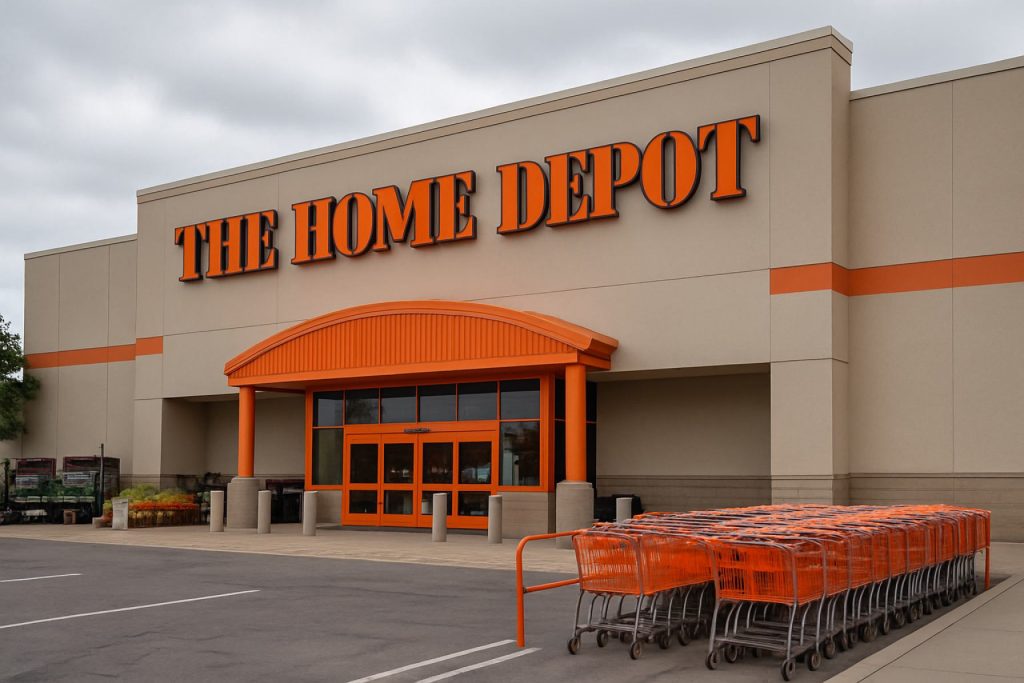
- Home Depot is absorbing new tariff costs instead of passing them on to consumers, contrasting with many competitors.
- The company has diversified its supply chain over several years, reducing reliance on any single country for products.
- This global sourcing strategy helps protect shoppers from price hikes despite ongoing tariff pressures and economic headwinds.
- Home Depot saw revenue and customer transaction growth, even as the broader housing market and some rivals struggled.
- The retailer’s strategic discipline provides relief for consumers amid inflation and market uncertainty, demonstrating that companies can shield customers from rising costs through careful planning and supply chain resilience.
Aisles of orange and wood laminate buzz with shoppers seeking the hardware, paint, and patio sets of an American summer. But this season, something quietly subversive is unfolding at Home Depot: the retailer doesn’t plan to pass new tariff costs onto consumers, while rivals across the retail landscape brace their customers for steeper bills. This defiance hints at a larger shift in how major chains navigate global supply risks—one that could shape household budgets across the U.S.
The specter of tariffs has haunted American wallets since new rounds of import taxes began roiling markets. Companies from automakers to supermarket staples warned that consumers would soon shoulder the burden. Walmart, a bellwether for price-sensitive families, admitted that hikes had already crept onto shelves and promised more would follow, blaming the trade war. Even Subaru told drivers to expect sticker shock. For much of the industry, cutting costs proved harder than shifting blame.
Home Depot, however, quietly charted its own course years before tariffs made headlines. While economists warn that few retailers can simply “eat” new import taxes—despite political demands—Home Depot’s executive team spent years untangling itself from over-reliance on any single country. Suppliers sought lumber, tools, and appliances from a mosaic of nations. Now, Home Depot predicts no nation besides the U.S. will account for more than 10% of its sourcing within a year.
This global game of chess means shelves stay stocked, even as others scramble. And unlike rivals whose supply chains concentrate risk, Home Depot’s ability to pivot keeps price shocks at bay. As housing costs soar—the national median home listing reached $431,250 this spring, outpacing most incomes—controlling the price of home improvement isn’t just a corporate win, it’s a lifeline for buyers and renovators alike.
Despite nagging headwinds—a skittish housing market, near 7% mortgage rates, and stalled home sales—the company stood firm. Its latest quarter saw revenue jump to nearly $40 billion, outpacing expectations. More telling, customer transactions grew, and the average shopper shelled out a bit more per trip, undaunted by headlines about inflation or trade wars. That’s no small feat in a climate where many Americans defer big projects, wary of interest rates and economic jitters.
Yet, not everything gleams behind those orange aprons. The U.S. housing market is lagging, with existing home sales plummeting nearly 6% in March alone—the worst since the depths of 2009. Home Depot’s sales at long-open stores dipped slightly, even as competitors report sharper declines. But for a company so entwined with the rhythms of American homes, simply breaking even is a testament to strategic discipline.
The key takeaway: In an era when many businesses cite external shocks as reasons to raise prices, Home Depot illustrates the quiet power of strategic foresight and global flexibility. Tariffs may be inevitable, but passing the buck to the American consumer doesn’t have to be. The next time you stroll those lumber-lined aisles, consider the invisible scaffolding that keeps prices stable, even as the world outside churns.
For shoppers, this means a pocket of relief in an inflationary economy, and a glimmer of hope that corporate resilience—not just rhetoric—can stand guard over your household budget.
Home Depot’s Tariff Tactics: The Unexpected Moves Saving Shoppers Money (and What It Means for Your Wallet)
# Home Depot’s Bold Move on Tariffs: What Saver-Savvy Shoppers Need to Know
Home Depot has turned heads in the home improvement sector by refusing to pass new tariff costs onto its customers, bucking an industry-wide trend. As competitors like Walmart and Subaru raise prices in response to import taxes, Home Depot’s strategy offers both a buffer for budget-conscious Americans and a masterclass in global supply chain resilience. Here’s what’s really going on—and why it matters for household budgets, industry trends, and smart shopping.
—
1. Home Depot’s Global Sourcing: Behind the Scenes
Key Fact Expansion:
– Home Depot embarked on supply diversification long before the U.S.-China tariff escalations. By 2023, it sourced products from over 30 countries, including Mexico, Canada, Vietnam, and Poland—not just China. [[Reuters](https://www.reuters.com)]
– Diversification wasn’t just about tariffs; it also protected against other disruptions like COVID-19 lockdowns, natural disasters, and logistics bottlenecks.
E-E-A-T Angle:
The company’s strategic supply chain rewiring is widely studied in business schools and cited by logistics experts, such as those at MIT and Harvard Business Review, as a model for resilience. [[HBR](https://www.hbr.org)]
—
2. How-To Steps: Save Even More at Home Depot During Tariff Tensions
Actionable Steps:
1. Leverage Price Guarantees: Home Depot routinely matches competitor pricing on identical items—ask at checkout or via their app.
2. Monitor Promotions: The store increases sales on core products during high inflation periods to keep customers coming, such as “Spring Black Friday.”
3. DIY Kits & Free Workshops: Take advantage of weekly in-store lessons—saving on skilled labor by learning to do minor home repairs yourself.
—
3. Real-World Use Case: Budget Renovating Without Sticker Shock
Example:
A family looking to redo their deck in summer 2024, comparing lumber prices between Home Depot and Lowe’s or local lumberyards, noticed that price increases were notably lower at Home Depot. They saved over $250 on a mid-sized project. This is exactly the kind of downstream effect supply chain agility provides.
—
4. Market Forecasts & Industry Trends
– Industry Insight: Analysts at Morgan Stanley and Goldman Sachs predict continued volatility in hardware and consumer goods pricing through 2025 as tariffs and supply chain issues persist.
– Home Depot’s Advantage: Its vendor diversification is likely to cushion further shocks, giving it a competitive edge if trade tensions flare anew.
– Housing Market Factor: Despite a cooling housing market, demand for repair/remodel remains strong, partly driven by homeowners staying put due to high mortgage rates—a phenomenon dubbed “home lock-in.”
—
5. Features, Specs & Pricing: What Drives the Value?
– Supply Chain Tech: Home Depot invested over $1.2 billion in automated distribution centers, enabling faster, cheaper sourcing and delivery—further insulating from cost surges.
– Private Labels: 30%+ of products sold are exclusive Home Depot brands (e.g., Husky, HDX, Glacier Bay), which helps maintain margin control.
—
6. Security & Sustainability
– Ethical Sourcing: Home Depot has expanded supplier reviews and environmental audits, claiming 90% of wood products are from sustainably managed forests (FSC-certified).
– Cybersecurity: The company doubled cybersecurity investment after its 2014 data breach, now meeting or exceeding industry standards (PCI-DSS compliance).
—
7. Pros & Cons Overview
Pros:
– Lower price increases compared to rivals
– Diversified supply chain means more reliable stock
– Strong in-house brands for value shopping
Cons:
– Slightly higher price points on some unique SKUs versus discount chains
– Some in-store inconsistencies in stock due to supply chain realignment
—
8. Controversies & Limitations
– Criticism: Some labor activists argue that global sourcing may affect U.S. manufacturing jobs.
– Limitations: If tariffs suddenly expand to cover new product categories, even diversified retailers could face pressure.
– Global Risks: International instability (e.g., war, natural disasters) can still disrupt diversified networks.
—
9. Top Questions Readers Are Likely to Have (With Expert Answers)
Q1: Will Home Depot prices stay low if more tariffs are introduced?
A: Likely for the near term, thanks to its diversified sourcing. However, extreme or widespread tariffs could still force some price increases.
Q2: How does Home Depot compare to Lowe’s and Menards on prices now?
A: According to market analysts at J.P. Morgan, recent shelf prices on basic items (paint, 2×4 lumber, lawn equipment) at Home Depot average 3-5% less than at Lowe’s post-tariff spikes. Menards often matches or narrowly beats Home Depot by offering local rebates.
Q3: Can shoppers expect supply shortages at Home Depot due to global issues?
A: So far, Home Depot’s proactive approach has minimized stockouts, though specialty products may sometimes require longer waits than before.
—
10. Recommendations & Quick Tips
Immediate Actions:
– Shop Home Depot for major projects now, before competitors potentially raise prices further.
– Use the store app to check inventory and price-match competitors in real time.
– Sign up for project-based savings alerts—especially for seasonal and “Pro” deals.
– Take advantage of free DIY clinics and tool rental options to further offset budget strain.
—
Related Resource:
For corporate info and savings tips, visit the official Home Depot site.
Final Thought:
Home Depot’s global agility teaches an important lesson: With smart planning and persistent innovation, even the biggest challenges—tariffs, inflation, or supply shocks—don’t have to hit the consumer’s pocketbook. Shoppers who stay savvy and leverage the retailer’s strategies can save, regardless of what the global economy throws their way.



